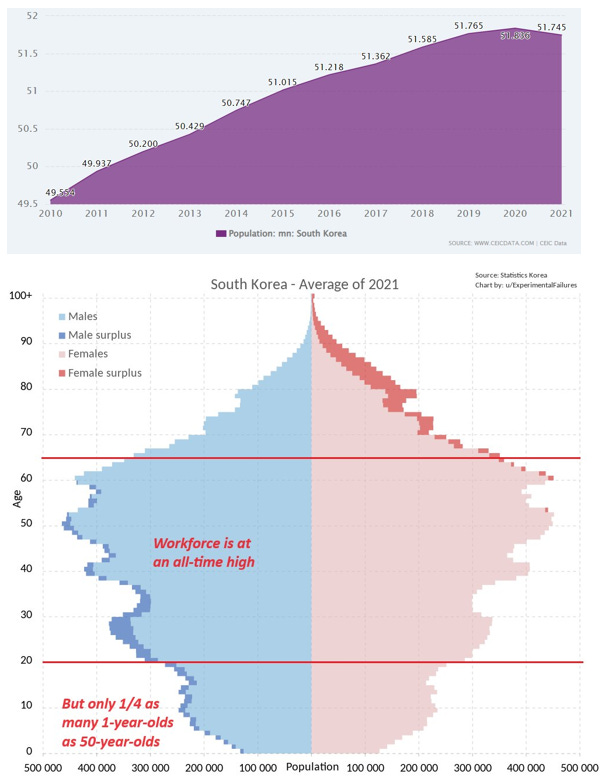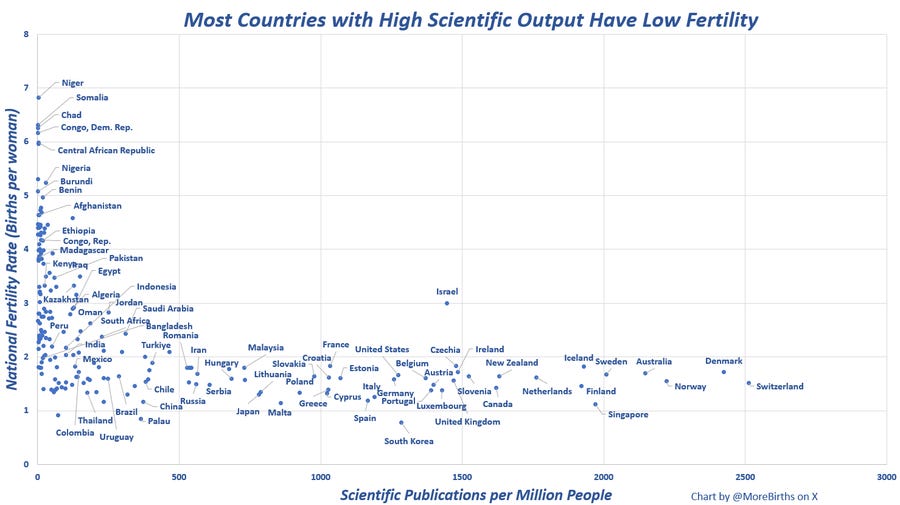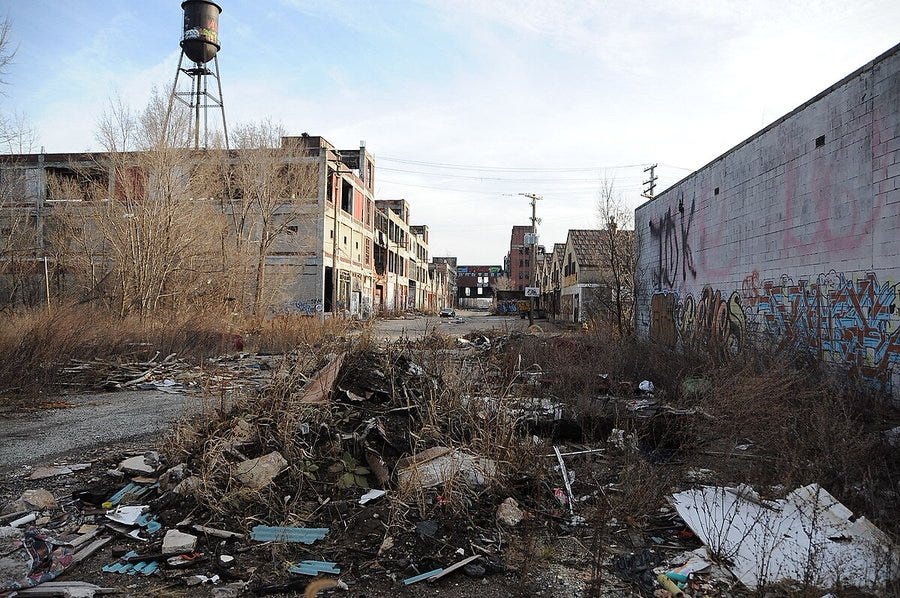Why Progressives Need to Care About Demographic Decline
In recent years, concern about birthrates and the need for more children has come to be seen as a conservative issue. Most on the left are much less worried about population decline. They point out that even though fertility has fallen, global population continues to rise. Most progressives reason that an end to population growth will give the planet a breather and represents a positive turn toward sustainability.
Shouldn't we celebrate falling birthrates as a victory for women’s rights? In any case, we aren't about to run out of people.
Yet a shrinking and aging world is not what most people think it will be. The places in the world that have depopulated and grown old do not match the progressive vision of fewer, but healthier and more thriving people. They do not fit anyone’s idea of sustainability. Instead, places losing people are depressed areas of decay and blight. Without the vibrancy of youth or an underlying sense of progress, the world will be sadder and drearier, and a whole lot poorer.
Stabilization? Don’t we wish!
In 1968 when Paul Ehrlich published The Population Bomb, the total fertility rate was 6.51 births per woman in China, 5.76 births per woman in India and 5.2 births per woman in Brazil. If those rates continued indefinitely, we would have big problems. Whatever the carrying capacity of Earth (and the fact that the world is better fed than ever shows that it is a lot higher than Ehrlich thought) it certainly isn’t infinite.
From that perspective, falling birthrates seem like a good thing. Unfortunately, the data show we have blown past 'balanced' birthrates in most countries and now things are crashing. Demographers sort of assumed that falling birth rates would settle down to around replacement and then hover there. That hasn’t happened. Almost no country that fell below replacement is managing a ‘soft landing’.
The fertility rate is now 1.9 births per woman in India, 1.57 births per woman in Brazil and just 1.02 births per woman in China, and still falling fast in all of these countries. Meanwhile very old countries like Germany, Japan and Spain, which fell below replacement many decades ago and have been trying to recover, just keep declining. Germany’s fertility is just 1.35 births per woman, less than 2/3 of replacement, while Japan is at just 1.20 and Spain’s fertility is a mere 1.13. Countries that fell below replacement aren’t steadying, they just keep crashing.
America’s fertility is only 1.6 births per woman, just 75% to 80% of replacement and far below the 2.7 children American women say they want (according to a 2023 Gallup poll). America makes up the difference with immigration, but soon all but the poorest and least-educated countries will face a demographic shortfall. The pool of skilled potential immigrants from around the world is drying up.
Meanwhile, the United Nations’ projections that everyone relies on are perennially much too high, based on the false hope that fertility rates will instantly stabilize after a precipitous fall. Every year, fertility instead continues its trend downward. For example, here is Argentina, according to the UN:
Somehow Argentina’s crashing birthrates will magically stabilize in an instant, the UN optimistically projects. (Spoiler, Argentina’s fertility rate for the first half of 2024 was just 1.28, already well below the latest UN projections and still falling.)
It takes a population pyramid to see what is really happening
A big part of the problem is that we think about population wrong. We see total population at or near its highest levels and think that surely the problem must be too many people rather than too few.
But total population is a poor metric for what is unfolding. Consider South Korea.
Korea is facing steep decline with a fertility rate that is just 1/3 of replacement. There are so few Korean children being born that for every 100 Koreans there will be just four Koreans three generations out. But if you look just at total population, the problem is completely hidden from view.
It’s hard to have progress if the world is declining
Almost all of us share something foundational in our worldview, and that is the idea of progress, however you define it. We have come to take for granted that the future will be better than the past. Life expectancies will keep increasing. Technology will keep improving. Science will advance and conditions will continue to improve.
Based on that, we assume that the mantra “it gets better” will continue to hold true. We expect that human rights will keep expanding and progress as we have known it will continue.
All that progress has come on the back of large populations in countries that embrace new knowledge and invest to develop new technology. Yet those countries are the very ones that are disappearing the fastest.
Consider that the parts of the world that are below replacement account for more than 90% of global GDP, and more than 95% of patents and scientific publishing.
As the population of technologically and scientifically advanced countries is set to dwindle, many imagine that things will be fine because some poor countries still have a lot of children. But some of those countries are not even interested in carrying progress forward.
Consider Afghanistan. Afghanistan’s recipe for fertility is to reject modernity, even to the point that girls are banned from education past the sixth grade. The education of boys is hardly better. The system that gives Afghanistan its high birthrate bears almost no relation to the scientifically advancing world that most of us want for the future.
If progress is the goal, we are unlikely to get it by looking to the least progressive countries for our demographic salvation.
What population decline really looks like
There is a happy vision that many have of a future world of declining population. There will be fewer of us, people think, but we will be more technologically advanced, healthier and richer.
What? Are we forgetting what declining places are really like? Think of Detroit, rural West Virginia and rural Japan. Detroit is pictured below. How is this a happy ending for the environment?
Oh, and by the way, the people in these depopulating regions aren’t doing well at all. The locales in America that are losing population have some of the worst social indicators of well-being, with deaths of despair being the most tragic metric.
Needless to say, these are rarely nice places to visit. Buildings that are unoccupied decay, rust and slowly fall down. The sense of missing people is sad. These are economically depressed places too, with many businesses closed and sales dwindling in the others because of too few customers.
What happens to real estate prices in areas that are depopulating? In Detroit, rural West Virginia, and rural Japan the answer is the same. When sellers vastly exceed buyers in a town that is losing people, many properties cannot catch a bid at any price, and so they go all the way to zero. Investing to maintain real estate that nobody will buy or rent is a guaranteed way to lose money, and so a great deal of property in such places is just left to decay.
Meanwhile, the recent population trend of Detroit, rural West Virginia, and rural Japan is the future almost everywhere else. Do we think this will be fine?
In fact, almost all investment is based on the assumption of growth. Who would invest in a store, factory or company if every year sales will be less than the year before?
We haven’t even begun to talk about the impact of declining demographics on things like pensions and social benefits programs. But we already know the answer. Detroit went bankrupt. Japan is struggling under a mountain of debt. West Virginia gets by because of spending from the Federal government.
When social safety nets go bust, the results are catastrophic for regular people. In Russia in the 1990s, life expectancy plunged when safety nets disappeared. If America or another developed country goes bankrupt or can no longer afford social spending due to population decline and aging, the human cost will be staggering.
The arc of history is moving toward pronatalism. Do progressives just plan to just cede one of the most important issues of the future to the right?
Demographic decline is not a made-up problem but a looming calamity that anyone who understands arithmetic and compounding should be able to understand. A post of mine from this Wednesday, which went viral and was retweeted by ElonMusk included a New York Times chart showing that births plunged by an average of 5% around the world between 2022 and 2023. If GDP numbers where down 5% year over year, we would be talking about little else, and yet births keep dropping, every year.
The world of the future will be pulled hard in a pro-natal direction. Just as tragedy and continued demographic threat has turned Israel toward pronatalism, so the severe stress that is coming will bend the United States and most countries in that direction.
Do progressives just plan to deny the crisis until it is plain to all, and leave the issue to conservatives? Do progressives believe that the right would do a better job with this than they would? Does history suggest that?
A lot of conservatives heed the advice of Napoleon: “Never interfere with your enemy when he is making a mistake” and revel in the very low birthrates of those on the political left. That is shortsighted and will leave us all worse off.
We will not remember well those who ignore this growing problem, or treat it like a political football, on either side.
Progressives are supposed to have a positive vision for the future
The depressing view of the antinatalism sub on Reddit (221K members, nearly all on the left), is that humanity should simply wind down because life is not worth living. That nihilistic outlook is surprisingly prevalent on the left today. Why aren't such ideas being forcefully rejected? By every objective measure, life is better today than it was for most of human history and nearly everyone is glad to be alive.
Progressives of the past would not understand people like this at all. The left of the past always had a positive vision of a bright human future, even when their policy prescriptions weren’t so great. Just look at every political poster ever. This strange despair about the future, so prevalent on the left today, would be out of place in any other era.
Those who care about the long run will surely have to turn toward pronatalism in some form. Because of how far birthrates have fallen, the status quo can’t hold. Given that, wouldn’t it better to lead on this than to follow?
The most effective solutions are cultural, and in culture, progressives have real power
Is the left powerless on falling birthrates? Hardly! Remember that it was progressives who took the lead when it seemed that overpopulation was looming and have been quite successful (much too successful in fact) in using culture, persuasion, technology and education to shift birthrates lower. That power has not gone away.
There is a lot of low hanging fruit to lift birthrates if the willpower is there:
Educate young people (especially in high-school health class) on the fertility window and the commonness of unplanned childlessness. Lack of planning and awareness early on is the biggest reason people fail to have the children they desire. Since the average woman will have fewer children than she wanted, just helping young people to know the terrain will go a long way toward solving the problem.
Shorten education tracks, created with men in mind, to accommodate the timescales of women who hope to have families.
Talk up marriage, the preferred vehicle for having a family for people across the spectrum.
Reject environmental or other doomerism that leads anti-natal sentiment.
Simply explain that low birthrates are a problem and that our society needs more children to thrive. Most people want to do good in the world and are already looking for how. ‘Have and raise children’ may be the best answer today.
(As Israel, France and the Republic of Georgia have all found, simple pronatal messages can remarkably effective.)






